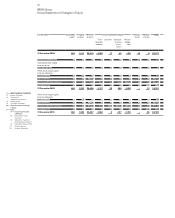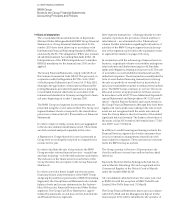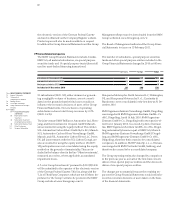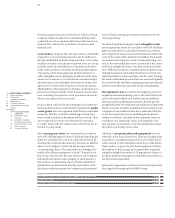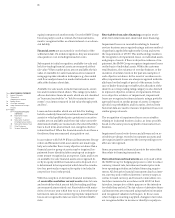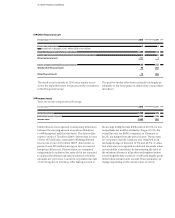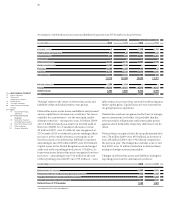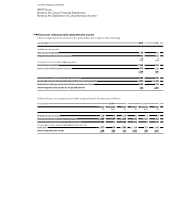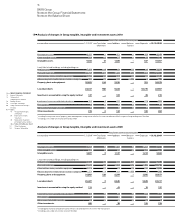BMW 2010 Annual Report Download - page 89
Download and view the complete annual report
Please find page 89 of the 2010 BMW annual report below. You can navigate through the pages in the report by either clicking on the pages listed below, or by using the keyword search tool below to find specific information within the annual report.87 GROUP FINANCIAL STATEMENTS
der accumulated other equity, depending on whether
thetransactions are classified as fair value hedges or cash
flow hedges. In the case of fair value hedges, the results
of the fair value measurement of the derivative financial
instruments and the related hedged items are recognised
in the income statement. In the case of fair value changes
in cash flow hedges which are used to mitigate the future
cash flow risk on a recognised asset or liability or on
forecast transactions, unrealised gains and losses on the
hedging instrument are recognised initially directly in
accumulated other equity. Any such gains or losses are
recognised subsequently in the income statement when
the hedged item (usually external revenue) is recog-
nised
in the income statement. The portion of the gains
or losses from fair value measurement not relating to
thehedged item is recognised immediately in the income
statement. If, contrary to the normal case within the BMW
Group, hedge accounting cannot be applied, the gains
or
losses from the fair value measurement of derivative
financial instruments are recognised immediately in the
income statement.
In accordance with IAS 12 (Income Taxes), deferred taxes
are recognised on all temporary differences between the
tax and accounting bases of assets and liabilities and on
consolidation procedures. Deferred tax assets also in-
clude claims to future tax reductions which arise from the
expected usage of existing tax losses available for carry-
forward (where future usage is probable). Deferred taxes
are computed using enacted or planned tax rates which
are expected to apply in the relevant national jurisdictions
when the amounts are recovered.
Inventories of raw materials, supplies and goods for re-
sale are stated at the lower of average acquisition cost
and net realisable value.
Work in progress and finished goods are stated at the lower
of average manufacturing cost and net realisable value.
Manufacturing cost comprises all costs which are directly
attributable to the manufacturing process and an
appro-
priate proportion of production-related overheads. This
includes production-related depreciation and an appro-
priate proportion of administrative and social costs.
Borrowing costs are not included in the acquisition or
manufacturing cost of inventories.
Provisions for pensions and similar obligations are
recognised using the projected unit credit method in ac-
cordance with IAS 19 (Employee Benefits). Under this
method, not only obligations relating to known vested
benefits at the reporting date are recognised, but also the
effect of future increases in pensions and salaries. This
involves taking account of various input factors which
are evaluated on a prudent basis. The calculation is based
on an independent actuarial valuation which takes into
account all relevant biometric factors.
Actuarial gains and losses arising on defined benefit
pension and similar obligations are recognised, net of
deferred tax, directly in equity.
The expense related to the reversal of discounting on
pension obligations and the income from the expected
return on pension plan assets are reported separately
aspart of the financial result. All other costs relating to
allocations to pension provisions are allocated to costs
by function in the income statement.
Other provisions are recognised when the BMW Group
has an obligation to a third party, an outflow of resources
is probable and a reliable estimate can be made of the
amount of the obligation. Measurement is computed on
the basis of fully attributable costs. Non-current provi-
sions with a remaining period of more than one year are
discounted to the present value of the expenditures ex-
pected to settle the obligation at the end of the reporting
period.
Financial liabilities are measured on first-time recogni-
tion at cost, which is equivalent to the fair value of the
consideration given. Transaction costs are included in this
initial measurement. Subsequent to initial recognition,
liabilities are, with the exception of derivative financial
instruments, measured at amortised cost. The BMW Group
has no liabilities which are held for trading. Liabilities
from finance leases are stated at the present value of the
future lease payments and disclosed under other finan-
cial liabilities.
The preparation of the Group Financial Statements in ac-
cordance with IFRSs requires management to make cer-
tain assumptions and estimates that affect the reported
amounts of assets and liabilities, revenues and expenses
and contingent liabilities. The assumptions and esti-
mates
relate principally to the groupwide determination
of economic useful lives, the measurement of invento-
ries, the recognition and measurement of provisions and
the recoverability of future tax benefits. All assumptions
and estimates are based on factors known at the end of
the reporting period. They are determined on the basis
of the most likely outcome of future business develop-
ments. This includes the situation in the automotive
sec-
tor and the general business environment. Estimates and
underlying assumptions are checked regularly. Actual





